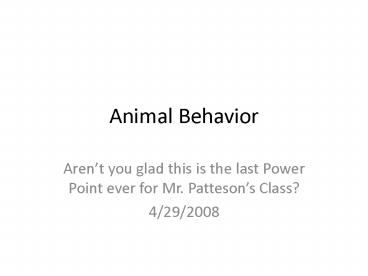Animal Behavior - PowerPoint PPT Presentation
1 / 24
Title:
Animal Behavior
Description:
Behavior the way an organsim reacts to changes in its internal condition or ... Duckling follows first moving object it sees. Can be sight or scent. Behavioral Cycles ... – PowerPoint PPT presentation
Number of Views:24
Avg rating:3.0/5.0
Title: Animal Behavior
1
Animal Behavior
- Arent you glad this is the last Power Point ever
for Mr. Pattesons Class? - 4/29/2008
2
Elements of Behavior
- Behavior? the way an organsim reacts to changes
in its internal condition or external environment - Stimulus? any kind of signal that carries
information and can be detected. - Response? single, specific reaction to a stimulus
3
Types of Stimuli and how animals respond
- Light, sound, odors, heat
- Not all animals can detect all stimuli
- When an animal responds to stimuli, body systems
( sense organs, nervous, muscles) interact to
produce behavior
4
Innate vs. Learned Behavior
- Innate Behavior
- Instinct or inborn behavior
- Fully functional form the first time it is
performed - Learned Behavior
- Or Acquired behaviors
- Altering behavior as a result of experience
5
Four Types of Learned Behavior
- Habituation
- Simplest
- animal stops response to a repetitive stimulus
(neither rewards nor harms) - 2. Classical Conditioning
- Connection between a stimulus and some kind of
reward or punishment.
6
Four Types of Learned Behavior cont
- 3. Operant Conditioning
- Animal learns through repeated practice.
- To avoid punishment or gain a reward.
- 4. Insight Learning
- Most complicated
- reasoning applying something known to solve
something new
7
Instinct and Learning Combined
- Imprinting
- Learning based on early experience once occurred
cannot be changed - Duckling follows first moving object it sees
- Can be sight or scent
8
Behavioral Cycles
- Animals have daily or seasonal cycles of behavior
- Migration
- Hibernation or dormancy
- Circadian rhythmsbehavioral cycles that occur in
daily patterns - Sleep at night
9
Behavioral Cycles cont
- Courtship
- Find and identify healthy mates passes genes to
the next generation - Social Behavior
- Animals interact with members of their species
- Society? group closely related animals of the
same species
10
Behavioral Cycles cont
- Competition and Aggression
- Protection of territory
- Aggression toward another animal
- Communication
- Passing information from one organism to another
- Use chemicals, visual, sound, touch
11
Invertebrates
- Groups of Invertebrates
- Sponges
- Cnidarians
- Worms
- Mollusks
- Arthropods
- Echinoderms
12
Invertebrates
- First Multicellular Animals
- Specialized Cells, Tissues and organs
- Sponges and cnidarians
- Flatworms have simple organs for digestion,
excretion, response, and reproduction
13
Invertebrates
- Body Symmetry
- All invertebrates have some symmetry (sponges no
symmetry) - Radial symmetry? body parts extend from the
center of the body - Bilateral symmetry? mirror image left and right
sides
14
Invertebrates
- Cephalization
- Concentration of sense organs and nerve cells in
the front of the body - Invertebrates rely on movement for feeding,
defense, and other important functions - With Cephalization can respond to environment in
more sophisticated way
15
Invertebrates
- Segmentation
- Most with bilateral symmetry have body segments
- Coelom Formation
- Coelom or body cavity
- Three germ layers
- Endoderm, mesoderm, and ectoderm
- Flatworms no coelom
- Pseudocoelomates (roundworms)
16
Invertebrates
- Feeding and Digestion
- Intracellular and Extracellular Digestion
- Respiration
- Respiratory organs have large surface areas
(diffusion occurs) - Aquatic Invertebrates
- Small use skin
- Larger use gills
17
Invertebrates
- Terrestrial Invertebrates
- Respiratory surfaces are covered with water or
mucus - Respiratory surfaces
- Mantle cavity
- Book lungs
- Spiracles
18
Invertebrates
- Circulation
- All cells require oxygen and nutrients and
removal of wastes - Complex animals use hearts and circulatory system
- Two types of circulatory system
- Openblood only partially contained within a
system of blood vessels - Closedheart or heart like organ forces blood
through vessels
19
Invertebrates
- Excretion
- All organisms must remove waste and controlling
water in the tissues - Aquatic Invertebrates
- Sponges , cnidarians, and roundworms diffuses
ammonia into surrounding water - Terrestrial Invertebrates
- Must conserve water while removing wastes
- Convert wastes into Urea
20
Invertebrates
- Response
- Three trends in evolution
- Centralization and Cephalization
- Simplest nervous systemsNerve net
- Ganglia few clumps of nerve tissue
- Brain in cephalopods ganglia are organized
- Specialization
- More complex an animals nervous system is the
more developed its sense organs
21
Invertebrates
- Movement and Support
- Muscles are used to move, breathe, pump blood
- Three kinds of skeletal systems
- Hydrostatic skeletons
- Annelids and cnidarians, muscles surround
fluid-filled body cavity - Exoskeletons
- Hard body covering made of chitin, muscles
attached to exoskeleton
22
Invertebrates
- Endoskeletons
- Structural support located inside body, sea stars
and other echinoderms - Made of calcified plates
23
Invertebrates
- Reproduction
- Most reproduce sexually during life cycle
- Many can reproduce asexually
- Asexual and sexual
- Two types of Sexual
- External Fertilization
- Eggs are fertilized outside the females body
- Internal Fertilization
- Eggs are fertilized inside the females body
24
- Congratulations!
- Lecture is over!































